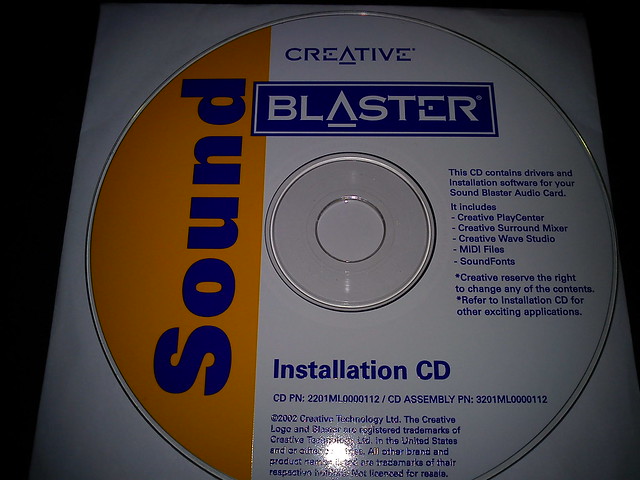Creative Sound Blaster Live 51 Cd Iso

Creative Music System The history of Creative sound boards started with the release of the Creative Music System ('C/MS') board in August 1987. It contained two circuits, which, together, provided 12 voices of square-wave bee-in-a-box stereo sound plus some noise channels. These circuits were featured earlier in various popular electronics magazines around the world.
For many years Creative tended to use off-the-shelf components and manufacturers' reference designs for their early products. The various integrated circuits had white or black paper sheets fully covering their top thus hiding their identity. On the C/MS board in particular, the Philips chips had white pieces of paper with a fantasy CMS-301 inscription on them; real Creative parts usually had consistent CT number references. Surprisingly, the board also contained a large 40-pin PGA (Creative Technology Programmable Logic) integrated circuit, bearing a CT 1302A CTPL 8708 inscription and looking exactly like the DSP of the later Sound Blaster. Presumably, it could be used to automate some of the sound operations, like. Sound Blaster 1.0 The first board bearing the Sound Blaster name appeared in 1989.
ECut Designer Toolkit for CorelDRAW 6 supports all full versions of CorelDRAW from CorelDRAW X3-2018. ECut was updated and is more powerful, faster and more convenient to use. The trial version will help you to try all features before purchase. For more information about compatibility, visit system requirements page. Home / CorelDRAW / eCut 6 for CorelDRAW – 1 installation. ECut 6 for CorelDRAW – 1 installation $ 129.95 $ 59.95. Here you can download latest version of eCut 6. ECut 6 works with all full versions of CorelDRAW since x3. Download eCut 6 (demo version) If you have problems starting plugin - see this topics: Nothing happens when pressing buttons. Gray and disabled program buttons. * more information about supporting read here. ECut 6 test mode. 
Jan 5, 2014 - This CD-ROM is divided into the following subdirectories: - AUDIO ENGLISH SETUP - Creative Sound Blaster Live! 5.1 (SB0060).
In addition to Game Blaster features, it had an 11-voice using the chip, also known as OPL2. It provided perfect compatibility with the then market leader sound card, which had gained support in PC games in the preceding years. Creative used the 'DSP' acronym to designate the digital audio part of the Sound Blaster. This actually stood for Digital SOUND Processor, rather than the more common, and was really a simple micro-controller from the family (supplied by Intel and, among others).
It could play back at up to 23 (approx. Quality) and record at up to 12 kHz (approx. The sole DSP-like feature of the circuit was decompression. An early 8-bit Sound Blaster The original card lacked an filter, resulting in a characteristic 'metal junk' sound. (This was rectified with the addition of two user-selectable filters in the later Sound Blaster Pro card.) It also featured a joystick port and a proprietary interface. In spite of these limitations, in less than a year, the Sound Blaster became the top-selling expansion card for the PC. It achieved this by providing a fully AdLib-compatible product, with additional features, for the same, and often a lower, price.
The inclusion of the game port, and its importance to its early success, is often forgotten or overlooked. PCs of this era did not include a game port. Game port cards were costly (around $50) and used one of the few expansion slots PCs had at the time.

Given the choice between an AdLib card or a fully-compatible Sound Blaster card that came with a game port, saved you a slot, and included the 'DSP' for not much more in price, many consumers opted for the Sound Blaster. In-game support for the digital portion of the card did not happen until after the Sound Blaster had gained dominance. Soundblaster 2.0 (CT1350B). The final revision of the original Sound Blaster, Sound Blaster 2.0 added support for 'auto-init', which assisted in producing a continuous loop of sound output.